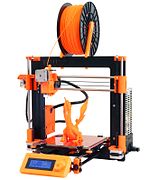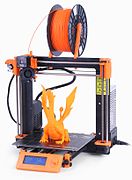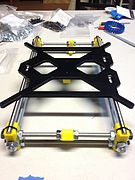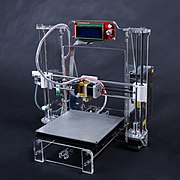Prusa i3
A Prusa i3 MK2 print farm producing parts for new printers | |
| Classification | Fused deposition modeling 3D printer |
|---|---|
| Inventor | Josef Průša |
| Manufacturer | Prusa Research |
The Prusa i3 is a family of fused deposition modeling 3D printers, manufactured by Czech company Prusa Research under the trademarked name Original Prusa i3. Part of the RepRap project, Prusa i3 printers were called the most used 3D printer in the world in 2016.[1] The first Prusa i3 was designed by Josef Průša in 2012, and was released as a commercial kit product in 2015. The latest model (Prusa MK4 on sale as of March 2023) is available in both kit and factory assembled versions. The Prusa i3's comparable low cost and ease of construction and modification made it popular in education and with hobbyists and professionals, with the Prusa i3 model MK2 printer receiving several awards in 2016.[2]
The i3 series is released under an open source license, so many other companies and individuals have made variants of the printer. The i3 moniker refers to the printer being the third iteration of the design.[3] It was used up until the Prusa i3 MK3 and its variants but was dropped from the latest model, Prusa MK4.
Models
-
Prusa Mendel
-
Prusa Mendel (iteration 2)
-
Prusa i3
-
Prusa i3 MK2
RepRap Mendel
First conceived in 2009, RepRap Mendel 3D printers were designed to be assembled from 3D printed parts and commonly available off-the-shelf components (referred to as "vitamins," as they cannot be produced by the printer itself).[4][5] These parts include threaded rods, leadscrews, smooth rods and bearings, screws, nuts, stepper motors, control circuit boards, and a "hot end" to melt and place thermoplastic materials.[6] A Cartesian mechanism permits placement of material anywhere in a cubic volume; this design has continued throughout development of the i3 series. The flat "print bed" (the surface on which parts are printed) is movable in one axis (Y), while two horizontal and two vertical rods permit tool motion in two axes, designated X and Z.
Prusa Mendel
Josef Průša was a core developer of the RepRap project who had previously developed a PCB heated "print bed". He adapted and simplified the RepRap Mendel design, reducing the time to print 3D plastic parts from 20 to 10 hours, and including 3D printed bushings in place of regular bearings.[7][8] First announced in September 2010, the printer was dubbed Prusa Mendel by Průša himself.[9] According to the RepRap wiki, "Prusa Mendel is the Ford Model T of 3D printers."[10][11]
Prusa Mendel (Iteration 2)
Průša streamlined his Mendel design, releasing "Prusa Iteration 2" in November 2011. Parts changes allowed for snap-fit assembly (no glue required); fewer tools were needed to construct and maintain this version. Although not required, fine-pitch manufactured pulleys and LM8UU linear bearings were recommended over printed equivalents for "professional" results.[12][13]
Prusa i3 and i3 1.75 mm
In May 2012, Průša released a major redesign, focused on ease of construction and use, and no longer structured around the simplest available common hardware as previous RepRap printers were.[14] The Prusa i3 design replaced the threaded-rod, triangular Z axis frame construction with a rigid, single-piece water jet cut aluminium vertical frame. This improved printing speed and accuracy by eliminating the need to erect, align and tighten the upper supports on the Mendel, which were easily skewed or twisted out of alignment from the base. M10 threaded rods were still used to support the heated bed Y axis. It used a single piece, food safe stainless steel hot end called the Prusa Nozzle which printed with 3 mm filament, and used M5 threaded rods as lead screws instead of M8.[15][16][17][18][19]
In May 2015, Průša released an i3 full kit under the brand name "Original Prusa i3".[1] After finding that 1.75 mm filament was far more common than 3 mm, Průša dropped the Prusa Nozzle and redesigned the extruder around a third-party hot end, the E3D V6-Lite. Noting that print quality was much improved, he introduced the new i3 1.75 mm version in August 2015.[20][21] The original model was retrospectively dubbed MK0 or "mark zero," while the new model came to be known as the "MK1."
Prusa i3 MK2 and MK2S
Průša released the Prusa i3 MK2 in May 2016. It was the first hobby 3D printer with mesh bed leveling and automatic geometry skew correction for all three axes. Features included a larger build volume, custom stepper motors with integrated lead screws, a non-contact inductive sensor for auto-leveling, and a rewritten version of the Marlin firmware.[22][23][24] Other new features include a polyetherimide print surface, Rambo controller board and an E3D V6 Full hotend.[25][26] The Prusa MK2 became the first RepRap printer to be supported by Windows 10 Plug-and-Play USB ID.[27]
In March 2017, Průša announced on his blog that the revised Prusa i3 MK2S would ship in place of the Prusa i3 MK2.[28] Enhancements cited include U-bolts to hold the LM8UU bearings where cable ties had been used, higher quality bearings and rods, an improved mount for the inductance sensor, improved cable management, and a new electronics cover. An upgrade kit was offered to owners of the MK2 to add these improvements.
Prusa i3 MK3 and MK2.5
In September 2017, Prusa i3 MK3 was released, marketed as "bloody smart."[29] Starting with this model, the base and Y axis were assembled with aluminum extrusion, eliminating the last of the structural threaded rods from the Mendel design. Included were a new extruder with dual Bondtech drive-gears, quieter fans with RPM monitoring, faster print speeds, an updated bed leveling sensor, a new electronics board named "Einsy", quieter stepper motors with 128 step microstepping drivers and a magnetic heatbed with interchangeable PEI-coated steel sheets.[30] Electrical components were updated to work with the new 24 volt power supply. The printer also offers dedicated sockets to connect Raspberry Pi Zero W running a fork of the open source OctoPrint software for wireless printing.
Ease-of-use features included a filament detector, allowing the printer to load filament when it is inserted, and to pause printing if the filament is jammed or runs out; error-correcting stepper motor drivers preventing layer shifts due to skipped steps; and recovery after power outages. The ambient temperature sensor both confirms suitable environment temperature and detects overheated electrical connections on the main board.
Existing MK2 and MK2S users were offered a $199 partial upgrade named MK2.5, limited to features which are cheaper to upgrade.[31] After negative feedback from the community, Prusa made available a more expensive $500 MK2S to MK3 full upgrade.[29][32]
Prusa i3 MK3S and MK3S+
In February 2019, Prusa i3 MK3S was released, along with the Multi Material Upgrade 2S (MMU2S), which allows selecting any of 5 different materials for printing together automatically.[33] MK3S changes include a simplified opto-mechanical filament sensor, improved print cooling, and easier access to service the extruder.[34]
Prusa made a running change starting November, 2020 to the Prusa i3 MK3S+.[35] This model has a revised bed leveling sensor and minor parts changes.
Prusa MK4

In March 2023 the company announced the Prusa MK4 and the Multi Material Unit version 3 (MMU3).[36] This model features a new version of their "Nextruder" extruder system first seen on the Prusa XL, no-adjustment load cell bed leveling, a modular replaceable all-metal hot end, a color touchscreen, and die-cast[37] aluminum frame, Y-carriage (heat bed support), and extruder frame.[38] The 32-bit main processor board includes additional safety and monitoring circuits, a network connector, a port for the MMU3, and a Wi-fi module. This is Prusa's first Mendel-based design to include support for local and cloud monitoring and support.
Switching to 0.9 degree stepping motors, and the addition of input shaping and pressure advance, allow the Mendel-style design to print faster while avoiding ringing artifacts and other undesirable patterns imposed on the object being made, even though it does not have the advantages of the box-like structure of CoreXY printers.[39] However, Průša has stated that print quality, not maximum speed, is their design goal. There is a provision for an accelerometer, often used in 3D printing for self-tuning of input shaping, but that component is not included in the final design.
When announced, software for input shaping, and sensor data collection were not finished, and the Multi Material Unit was not ready for release. Upgrade kits for earlier models likewise were not available for shipping. On February 5th, 2024 upgrade kits to MK3.5 for the MK3 began shipping.[40][41] Touch screen operation was not formally enabled until April 2024.[42]
Other Prusa models
Following the MK3S, Prusa introduced unrelated models such as the Prusa SL1 (SLA printer), the Prusa Mini (with a cantilever arm) and Prusa XL (using a Core XY method inside a full-frame structure). These printers are not iterations of the Mendel frame design.
Variants
With all aspects of the design freely available under open source and open hardware terms, companies and individuals around the world have produced Prusa i3 copies, variants, and upgrades in assembled and kit form, with thousands offered for sale as early as 2015.[43][44][45] Rather than compete directly with these, Prusa Research's strategy is to pursue continual refinement of its designs.[46]
Recognition
- In 2012, Josef Průša received honors from the governor of the Vysočina Region in the Czech Republic for his accomplishments in technology.[47]
- In February 2014 he was featured on the cover of Czech Forbes magazine as one of the 30 under 30 list.[48]
- The MK2 and MK2S printers both won Best Overall 3D Printer awards from Make: Magazine.[49]
- Deloitte placed Prusa Research at the top of the 2018 Deloitte Technology Fast 50 as the fastest growing company in Central Europe.[50][51]
- The 3D Hubs Q3 2018 Trends report noted that the Prusa i3 MK2, MK2S and MK3 had been used to manufacture nearly 35% of all prints ordered through their fee-for-service business.[52]
- The MK3 was named FFF 3D printer of the year for 2019 by 3D Printing Industry.[53]
- Průša was again featured on the cover of the Czech edition of Forbes in 2019 for his leadership at the now billion-koruna company.[54]
- All3DP named the MK3 Best 3D Printer of 2018, and the MK3S Best 3D Printer of 2020.[55][56]
- The MK3S and MK3S+ were identified as "Our pick"[57] or "Upgrade pick"[58] by the prominent Wirecutter review site from 2020 until supplanted by Bambu Labs products late in 2023.[59]
Components and materials

Plastic parts
All Prusa i3 models use 3D printing filament as feedstock to make parts.
Like other RepRap printers the Prusa i3 is capable of creating many of its own parts, with the designs freely available for repairs, replication, and redesign. Formerly these were printed in ABS plastic; Prusa Research now uses mostly PETG instead.[60] Prusa Research maintains a "print farm" of 600 3D printers (as of October 2021) to manufacture the plastic parts for Original Prusa branded products.[61][62]
-
Metal frame and constructed X axis, printed parts in yellow.
-
Assembled Y axis, printed parts in yellow.
-
The original Prusa i3 MK0 extruder and hot end with yellow printed parts.
-
Completed Prusa i3, printed parts in yellow.
Control system
When the Prusa i3 design was first introduced in 2012, RepRap printers frequently used Open Hardware controllers such as an Arduino Mega combined with an Arduino shield providing the remaining circuitry, such as the RAMPS board.[63] All-in-one versions such as the RAMBo board were becoming available.[64] As a commercial product, Original Prusa i3 up to MK2 used Mini-Rambo. MK3 versions switched to Einsy Rambo boards to provide desired features such as quieter operation.[65] The MK4 uses xBuddy, the first 32-bit board used in the i3 series.[66]
All Original Prusa products use Marlin 3D printing firmware.[67][68][69]
First layer control and bed leveling
When extruding the first layer, the print head must be a precise distance away from the print bed for proper adhesion. Many 3D printers rely on the user to complete this process by adjusting the height of the bed at several locations ("bed leveling"). To automate this process, Prusa i3 models from the MK2 in 2016 have sensor called PINDA (Prusa INDuction Autoleveling[70]) to detect the height of the printbed at different locations, and then adjust for it when printing ("auto-leveling").[71]
- PINDA V1 - A non-contact inductive sensor used on MK2/S and MINI.
- PINDA V2 - A thermally compensated inductive sensor used on MK2.5, MK2.5S, MK3, and MK3S.
- SuperPINDA - A thermally insensitive sensor used with MK2.5/S, and MK3/S/+.[72]
- Load cell sensor - A contact sensor used on the MK4.
The PINDA series requires an electronic Z-height adjustment that may vary for different heat bed surfaces or different nozzles. The load cell sensor automatically compensates for variations in nozzle size, and thickness and expansion of the heated bed surface, eliminating stored settings for the purpose.
Frames
The distinguishing feature of the i3 from its predecessors is the vertical frame, which can take many forms. These include single sheet frames cut from steel or acrylic, box frames from plywood or medium-density fibreboard, and Lego.[73][74][75][76] Inexpensive aluminum extrusion is commonly used, both by printer enthusiasts and by manufacturers of "clone" i3 printers.[77][78] Some mass market i3 variants, such as many Shenzhen Creality products, use rollers against the extruded frame itself instead of precision rods and bearings to reduce cost and complexity.
-
A Prusa i3 with a standard metal frame.
-
A Prusa i3 with an acrylic frame.
-
A Prusa i3 with a plywood box frame.
-
A Prusa i3 with a melamine-resin particle board frame.
Extruders
Beyond the standard Prusa i3 filament extruders, others have created aftermarket extruders and enthusiast tool heads, including a MIG welder and a laser cutter.[79][80][81] Průša offered a collection of functional cooking tools and programs under the name "MK3 Master Chef Upgrade" as an April Fools' Day gag in 2018.[82]
-
A partially printed single-colour object showing the infill created to increase rigidity and reduce the amount of plastic used.
-
A 3DBenchy created on a Prusa i3 using a color-mixing hot end.
See also
References
- ^ a b "What's up with Original Prusa i3? – Prusa Printers". Prusa Printers. March 2, 2016. Retrieved June 13, 2016.
- ^ Ertischek, David (February 3, 2016). "Prusa I3 is a DIY 3D printer you can actually afford". Boy Genius Report. Retrieved June 12, 2016.
- ^ Průša, Josef (February 9, 2015). "Prusa i3 3D printer". Original Prusa 3D printers.
- ^ "Mendel - RepRap". reprap.org. Retrieved January 12, 2021.
- ^ "Distributing 3DP Parts — and Vitamins — With Passion". 3D Printing Industry. August 12, 2013. Retrieved June 15, 2016.
- ^ "Hot End Design Theory - RepRap". reprap.org. Retrieved January 12, 2021.
- ^ Thingiverse.com. "PCB heated print bed by josefprusa". www.thingiverse.com. Retrieved June 19, 2016.
- ^ "first commit · josefprusa/PrusaMendel@6ed4480". GitHub. Retrieved June 13, 2016.
- ^ {https://www.reprap.org/mediawiki/index.php?title=Prusa_Mendel&oldid=19530}
- ^ Prusa, Josef (October 4, 2010). "RepRap: Blog: Story of simpler Mendel: PLA bushings and X-axis". Retrieved May 18, 2021.
- ^ User "Scwimbush"; User "Prusajr" (April 12, 2011). "Prusa Mendel - RepRap". reprap.org. Retrieved October 9, 2020.
{{cite web}}:|last1=has generic name (help) - ^ "Hobbyist Weekend – With Prusa Mendel 3D Printer". 3D Printing Industry. November 3, 2012. Retrieved June 15, 2016.
- ^ Průša, Joseph (November 11, 2011). "RepRap: Blog: Prusa Iteration 2". Retrieved April 19, 2021.
- ^ "initial commit · josefprusa/Prusa3@d3618a6". GitHub. Retrieved June 13, 2016.
- ^ "Open Source 3D printing: an Interview with Josef Prusa". Open Electronics. February 5, 2013. Retrieved June 16, 2016.
- ^ By (November 19, 2014). "Interview With A Printer". Hackaday. Retrieved June 17, 2016.
- ^ "Prusa Nozzle: All metal food safe RepRap hot-end". 3ders.org. Retrieved June 19, 2016.
- ^ By (April 29, 2016). "Fail Of The Week: My 3D Printer Upgrade". Hackaday. Retrieved June 15, 2016.
- ^ Research, Josef Prusa / Prusa. "Prusa Nozzle". prusanozzle.org. Retrieved January 12, 2021.
- ^ Průša, Josef (August 26, 2015). "Original Prusa i3 is now 1.75 mm!". Original Prusa 3D Printers. Retrieved April 26, 2024.
- ^ "About Josef Prusa and Prusa Research". Prusa3D - 3D Printers from Josef Průša. Retrieved January 12, 2021.
- ^ Gerrit Coetzee (June 15, 2016). "Prusa Shows Us the New i3 MK2 3D Printer and Where the Community is Headed". Hackaday. Retrieved December 24, 2019.
- ^ "Josef Prusa unveils $699 Original Prusa i3 MK2 3D printer". 3ders.org. Retrieved December 24, 2019.
- ^ "The first printer to correct its geometry in all axes - Prusa Printers". August 11, 2016. Retrieved August 13, 2016.
- ^ "The All New Original Prusa i3 MK2 Kit Has a Ton of New Features". 3DPrint.com. May 18, 2016. Retrieved June 19, 2016.
- ^ "Interview with Josef Prusa, CEO and Founder of Prusa Research". 3D Printing Industry. June 9, 2016. Retrieved June 12, 2016.
- ^ "Microsoft adds network 3D printing support with Windows 10 IoT Core app for Raspberry Pi 3". 3ders.org. Retrieved June 12, 2016.
- ^ "Original Prusa I3 MK2S Release". Official Prusa 3D printers community. March 10, 2017. Retrieved April 13, 2017.
- ^ a b "Original Prusa i3 MK3 is out! And it's bloody smart!". Prusa Printers. September 22, 2017. Retrieved March 27, 2021.
- ^ "New Original Prusa i3 MK3: Review the Facts Here! | All3DP". All3DP. September 25, 2017. Retrieved October 24, 2017.
- ^ "Upgrade Your Prusa i3 MK2 with the "MK2S" Kit". All3DP. March 27, 2017. Retrieved March 27, 2021.
- ^ "Prusa Research Offers MK3 Upgrade Kit for Older MK2/S Models". All3DP. October 19, 2017. Retrieved March 27, 2021.
- ^ "Original Prusa i3 MK3S and MMU2S release, SL1 and powder-coated sheets update". Prusa Printers. February 12, 2019. Retrieved October 9, 2020.
- ^ May 2019, Ali Jennings (May 31, 2019). "Original Prusa i3 MK3S review". TechRadar. Retrieved March 27, 2021.
{{cite web}}: CS1 maint: numeric names: authors list (link) - ^ Průša, Josef (November 24, 2020). "November 2020 Update: Original Prusa i3 MK3S+ and MINI+ now shipping, MINI+ kit in the works, new steel sheet available". Prusa Printers. Retrieved December 15, 2020.
- ^ Les Pounder (March 29, 2023). "Prusa Announces Next-Gen, MK4 3D Printer". Tom's Hardware. Retrieved April 2, 2023.
- ^ Prusa, Josef (March 29, 2023). "Original Prusa MK4 is here: Always perfect first layer, high-speed printing with Input shaper, 32-bit platform, Nextruder, MMU3. SHIPPING NOW!". prusa3d.com.
- ^ Everything you need to know about the new Prusa MK4!, retrieved April 2, 2023
- ^ Harter, Kevin (March 5, 2021). "What is a CoreXY 3D Printer? Find the Advantages & Disadvantages (2023)". Retrieved April 2, 2023.
- ^ 3Printr.com (February 8, 2024). "Prusa introduces MK3.5 upgrade for faster 3D printing". 3Printr.com. Retrieved March 27, 2024.
{{cite web}}: CS1 maint: numeric names: authors list (link) - ^ Průša, Josef (February 7, 2024). "Original Prusa MK3.5 Upgrade is here: Make your MK3S/+ two times faster!". Original Prusa 3D Printers. Retrieved March 27, 2024.
- ^ "New Firmware 6.0.0 Introduces Advanced Features for Prusa's Latest 3D Printers « Fabbaloo". Fabbaloo. Retrieved April 26, 2024.
- ^ By (December 30, 2012). "[Prusa] interviews a whole bunch of RepRappers". Hackaday. Retrieved June 17, 2016.
- ^ "cheap chinese 3d printers ebay". reprap.org. Retrieved March 27, 2021.
- ^ Prusa, Josef (March 18, 2015). "RepRap Prusa i3 as a 3D Printer benchmark". Prusa Printers. Retrieved August 16, 2021.
- ^ "What's up with Original Prusa i3?". March 2, 2016.
- ^ "Jihlavské listy | Aktuality | Noviny Kraje Vysočina". www.jihlavske-listy.cz. Retrieved June 13, 2016.
- ^ "Forbes Česko". www.facebook.com. Retrieved June 13, 2016.
- ^ "Prusa i3 MK2S". Make: DIY Projects and Ideas for Makers. November 6, 2018. Retrieved January 12, 2021.
- ^ "Deloitte Technology Fast 50 | Deloitte Central Europe". Deloitte Macedonia. Retrieved May 23, 2020.
- ^ "Deloitte Fast 500 EMEA: Two Czech companies in Top 5". Deloitte Czech Republic. Retrieved May 23, 2020.
- ^ "3D Printing Trends Q3 2018" (PDF). 3D Hubs. Retrieved November 30, 2018.
- ^ "2019 3D Printing Industry Awards winners announced". 3D Printing Industry. June 11, 2019. Retrieved July 8, 2019.
- ^ "3D punk". Forbes (in Czech). Retrieved May 23, 2020.
- ^ "Original Prusa i3 MK3 Review: Best 3D Printer of 2018". All3DP. May 5, 2019. Retrieved January 12, 2021.
- ^ "Original Prusa i3 MK3S Review: Best 3D Printer 2020". All3DP. June 18, 2020. Retrieved January 12, 2021.
- ^ "Best 3D Printer 2020 | Reviews by Wirecutter". The New York Times. July 19, 2020. Archived from the original on July 19, 2020. Retrieved November 26, 2023.
- ^ "The 4 Best 3D Printers for 2023 | Reviews by Wirecutter". The New York Times. March 30, 2023. Archived from the original on March 30, 2023. Retrieved November 26, 2023.
- ^ "The Best 3D Printer". The New York Times. November 2, 2023. ISSN 0362-4331. Retrieved November 26, 2023.
- ^ "Original Prusa i3 Mk3 after 2 months". prusaprinters.org. January 22, 2018. Retrieved March 14, 2018.
- ^ "The great recap of 2020 in Prusa Research and plans for 2021". Prusa Printers. January 14, 2021. Retrieved July 31, 2021.
- ^ Sertoglu, Kubi (October 4, 2021). "Prusa showcases its new modular 3D printer farm at Dubai's Expo 2020". 3D Printing Industry. Retrieved January 13, 2022.
- ^ "Arduino Mega Pololu Shield - RepRap". reprap.org. Retrieved May 10, 2023.
- ^ "Rambo - RepRap". reprap.org. Retrieved May 10, 2023.
- ^ "EinsyRambo - RepRap". reprap.org. Retrieved May 10, 2023.
- ^ "Prusa MK4 vs MK3S+". 4dfiltration.com. Retrieved May 10, 2023.
- ^ jbrazio (May 9, 2023). "What is Marlin?". Marlin Firmware. Retrieved May 10, 2023.
- ^ "Introduction | Prusa Knowledge Base". help.prusa3d.com. Retrieved May 10, 2023.
- ^ "Release 3.0.12-RC2 firmware for Prusa i3 MK2 · prusa3d/Prusa-Firmware". GitHub. Retrieved May 10, 2023.
- ^ "P.I.N.D.A./SuperPINDA Sensor testing". Prusa Research. Retrieved June 16, 2024.
- ^ "Inductive Sensor (3D Printer): All You Need to Know". All3DP. May 30, 2021. Retrieved November 5, 2021.
- ^ PINDA/SuperPINDA Sensor testing January 2022
- ^ O'Neal, Bridget (June 6, 2016). "Portugal's Reprapalgarve Team Shows Us How to Make a Steel Framed Color 3D Printer for Around $600". 3DPrint.com. Retrieved August 6, 2016.
- ^ O'Neal, Bridget (December 18, 2014). "RepRap iTopie Emerges as Improvement on Prusa i3". 3DPrint.com. Retrieved August 16, 2016.
- ^ Sweatman, Will (June 8, 2015). "Lego Printer Prints Lego". Hackaday. Retrieved August 16, 2016.
- ^ Buren, Alec (June 3, 2015). "Build your very own Prusa l3 LEGO 3D printer using (almost) nothing but LEGO bricks". 3ders.org. Retrieved August 16, 2016.
- ^ "Creality CR-10 S5 Review". Maker Hacks. September 18, 2017. Retrieved January 12, 2021.
- ^ "Prusa Bear (Full) Upgrade – Is It Worth it?". All3DP. November 24, 2020. Retrieved January 12, 2021.
- ^ "Dutch students build DIY metal 3D printer using Prusa i3 printer and a MIG welder". 3ders.org. Retrieved June 19, 2016.
- ^ "Students Combine Prusa i3 Printer with a MIG Welder to Create an Affordable Metal 3D Printer". 3DPrint.com. November 17, 2014. Retrieved June 19, 2016.
- ^ "DIY 3D Printing: Laser cutting with Prusa Mendel i2". diy3dprinting.blogspot.co.uk. August 2013. Retrieved June 19, 2016.
- ^ "New upgrade for the Original Prusa i3 MK3 is here to change your life". Prusa Printers. April 1, 2018. Retrieved January 12, 2021.














